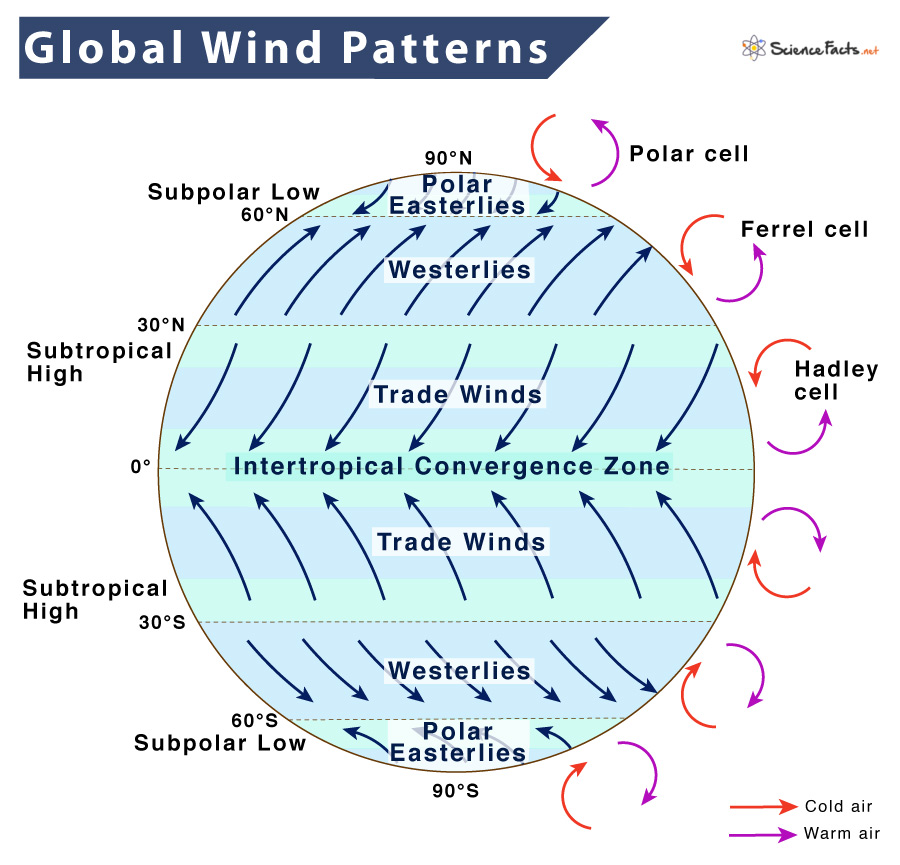Global winds are winds that develop in belts distributed all around the world. Like local winds, the leading cause of global winds is unequal heating of the atmosphere, causing a difference in air pressure.
What Causes Global Wind Patterns
What Factors Contribute to Global Winds
What are Global Wind Belts
How Do Global Winds Affect Climate
Jet Streams and Global Wind Belts
Almost 30° north and 30° south of the Equator, this air cools and descends to create high-pressure zones called Subtropical High-Pressure Zones. Cold air at the poles descends and creates Polar High-Pressure Zones. The cold polar air moves at about 60° north and south towards the Equator and starts rising. This unique, permanent movement of winds across the surface of the Earth due to permanent air pressure zones creates a distinct pattern known as global wind patterns or global wind systems. However, global winds do not move directly from north to south or south to north due to the rotation of the Earth. All winds in the Northern Hemisphere curves to the right as they move. Contrastingly, winds appear to curve to the left in the southern hemisphere. This apparent shift in the path of the wind moving about the Earth’s surface due to the Earth’s rotation is called the Coriolis Effect. The global movement of air on the Earth in the three atmospheric convection cells is summarized below:
Unequal heating of the Earth High and low-pressure areas (Pressure Gradients)Coriolis EffectConvection Cells
1. Tropical Easterlies (Trade Winds)
Location – 0° to 30° Latitude They are persistent winds that blow westward and toward the Equator from the subtropical high-pressure belt. Trade Winds finally converge at an area near the ITCZ, producing a narrow band of clouds, and thunderstorms encircle portions of the globe. It is more robust and consistent over the oceans than the land, often producing partly cloudy sky conditions characterized by shallow cumulus clouds or clear skies. Most tropical storms, including hurricanes, cyclones, and typhoons, develop as trade winds.
2. Westerlies
Location – 30° to 60° Latitude They are moist prevailing winds that blow from the subtropical high-pressure belts towards sub-polar low-pressure belts. Westerlies come from the southwest in the Northern Hemisphere and the northwest in the Southern Hemisphere. Westerlies are essential in carrying the warm, equatorial winds to the western coasts of continents.
3. Polar Easterlies
Location – 60° to 90° Latitude They are dry, cold prevailing winds that blow from the high-pressure areas of the polar highs in both hemispheres. They flow towards low-pressure areas within the Westerlies at high latitudes. Cold air subsides at the pole creating high pressure, creating a northward flow of wind towards the Equator in the southern hemisphere. The flow is then deflected westward by the Coriolis Effect. Thus, these prevailing winds blow from the east to the west. Since the winds originate in the east, they are then known as easterlies. They also develop due to the unequal heating of the Earth’s surface, creating a vast temperature difference between two air masses. Jet streams circle the planet, mainly from west to east, but the flow often shifts to the north and south. The polar jets are the strongest jet streams that blow between about 30°N and 50° to 75°N. They blow towards the south in the winter and north in the summer.
